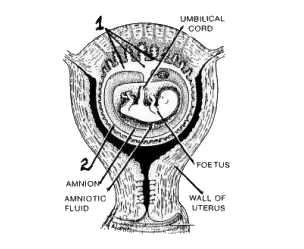Blood flowing through umbilical cord of mammalian embryo is
100% foetal
100% maternal
50% maternal and 50% foetal
75% maternal and 25% foetal
The correct Answer is:A
Step-by-Step Solution:
1. Understanding the Umbilical Cord: The umbilical cord is a vital structure that connects the developing embryo (fetus) to the placenta in mammals. It is composed of one vein and two arteries.
2. Function of the Umbilical Cord: The umbilical cord serves as a conduit for blood flow between the mother and the fetus. The two umbilical arteries carry deoxygenated blood away from the fetus to the placenta, while the umbilical vein carries oxygenated blood from the placenta back to the fetus.
3. Blood Composition: The blood that flows through the umbilical cord is primarily fetal blood. The umbilical vein carries blood that is rich in oxygen and nutrients, which is essential for the growth and development of the fetus.
4. Clarifying Blood Types: The blood in the umbilical cord is 100% fetal blood. This means that the blood circulating through the umbilical cord is entirely derived from the fetus and not mixed with maternal blood.
5. Conclusion: Based on the functions and composition of the blood in the umbilical cord, the correct answer to the question is that the blood flowing through the umbilical cord of a mammalian embryo is 100% fetal blood.
Final Answer: The blood flowing through the umbilical cord of a mammalian embryo is 100% fetal blood.
---
Topper's Solved these Questions
Similar Questions
Knowledge Check
Blood flows through sinuses in
Apulmonary circulationBsystemic circulationCopen circulatory systemDclosed circulatory systemStatement-1: The final reabsorption of water from the urine into the blood occurs through the collecting duct of a mammalian nephron resulting in thhe production of hyperosmotic urine.
Statement-2: The loop of henle creates a sodium gradient in the interstitial fluid.Aboth statements 1 and 2 are correct.BStatement 1 is correct but statement 2 is incorrectCStatement 1 is incorrect but statement 2 is correctDBoth statements 1 and 2 are incorrect.
The amnion of mammalian embryo is derived from
View SolutionThe yolk sac of mammalian embryo is derived from
View SolutionA : placenta is connected to the embryo through an umbilical cord which helps in the transport of substance to and from the embryo
R : Palcenta acts as an endocrine tissue
View SolutionWhat does the blastocoel of mammalian embryo phylogenetically signify about the ancestors?
View SolutionGo through this figure of L.S. of an embryo of grass

View SolutionStudy the diagram given below and then answer the questions that follow:

What is the role of the umbilical cord in the development of the foetus?
View Solution
